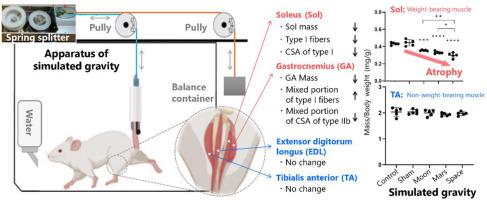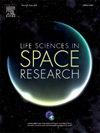Disparity in the effect of partial gravity simulated using a new apparatus on different rat hindlimb muscles
IF 2.8
3区 生物学
Q2 ASTRONOMY & ASTROPHYSICS
引用次数: 0
Abstract
The days of returning to the Moon and landing on Mars are approaching. These long-duration missions present significant challenges, such as changes in gravity, which pose serious threats to human health. Maintaining muscle function and health is essential for successful spaceflight and exploration of the Moon and Mars. This study aimed to observe the adaptation of rat hindlimb muscles to partial gravity conditions by simulating the gravity of space (microgravity (µG)), Moon (1/6G), and Mars (3/8G) using our recently invented ground-based apparatus. A total of 25 rats were included in this study. The rats were divided into five groups: control (1G), sham (1G), simulated Mars (3/8G), simulated Moon (1/6G), and simulated Space (µG). Muscle mass, fiber proportion, and fiber cross-sectional area (CSA) of four types of hindlimb muscles were measured: gastrocnemius (GA), tibialis anterior (TA), extensor digitorum longus (EDL), soleus (Sol). Sol and GA exhibited the most significant alterations in response to the changes in gravity after 10 days of the experiment. A notable decline in muscle mass was observed in the simulated µG, Moon, and Mars groups, with the µG group exhibiting the most noticeable decline. In Sol, a noteworthy decline in the proportion of slow-twitch type I fibers, CSA of slow-twitch type I fibers, and average CSA of the whole muscle fibers was observed in the simulated groups. The GA red, mixed, and white portions were examined, and the GA mixed portion showed significant differences in fiber proportion and CSA. A notable increase in the proportion of slow-twitch type I fibers was observed in the simulated groups, with a significant decrease in CSA of type IIb. In EDL or TA, no discernible changes in muscle mass, fiber proportion, or fiber CSA were observed in any of the five groups. These findings indicate that weight-bearing muscles, such as Sol and GA, are more sensitive to changes in partial gravity. Furthermore, partial gravity is insufficient to preserve the normal physiological and functional properties of the hindlimb muscles. Therefore, targeted muscle interventions are required to ensure astronauts' health and mission success. Furthermore, these findings demonstrate the viability and durability of our ground-based apparatus for partial gravity simulation.

使用新仪器模拟部分重力对不同大鼠后肢肌肉影响的差异
重返月球和登陆火星的日子即将到来。这些长时间的任务带来了巨大的挑战,如重力变化,对人类健康构成严重威胁。保持肌肉功能和健康是成功进行太空飞行和探索月球与火星的关键。本研究旨在利用我们最近发明的地面仪器模拟太空重力(微重力(µ))、月球重力(1/6)和火星重力(3/8),观察大鼠后肢肌肉对部分重力条件的适应情况。本研究共包括 25 只大鼠。大鼠被分为五组:对照组(1 只)、假体组(1 只)、模拟火星组(3/8 只)、模拟月球组(1/6 只)和模拟太空组(µ 只)。测量了四种后肢肌肉:腓肠肌(GA)、胫骨前肌(TA)、趾长伸肌(EDL)和比目鱼肌(Sol)的肌肉质量、纤维比例和纤维横截面积(CSA)。实验 10 天后,比目鱼肌和腓肠肌对重力变化的反应变化最为显著。模拟 µ 组、月球组和火星组的肌肉质量明显下降,其中 µ 组的下降最为明显。在 "溶胶 "模拟组中,慢速肌I型纤维的比例、慢速肌I型纤维的CSA和整个肌纤维的平均CSA都出现了显著下降。对 GA 的红色、混合和白色部分进行了检查,GA 混合部分的纤维比例和 CSA 有显著差异。在模拟组中,慢速肌腱 I 型纤维的比例明显增加,IIb 型纤维的 CSA 明显减少。在 EDL 或 TA 中,五组肌肉的肌肉质量、纤维比例或纤维 CSA 均未观察到明显变化。这些研究结果表明,负重肌肉(如 Sol 和 GA)对部分重力的变化更为敏感。此外,部分重力不足以保持后肢肌肉的正常生理和功能特性。因此,需要对肌肉进行有针对性的干预,以确保宇航员的健康和任务的成功。此外,这些研究结果还证明了我们用于部分重力模拟的地面设备的可行性和耐用性。
本文章由计算机程序翻译,如有差异,请以英文原文为准。
求助全文
约1分钟内获得全文
求助全文
来源期刊

Life Sciences in Space Research
Agricultural and Biological Sciences-Agricultural and Biological Sciences (miscellaneous)
CiteScore
5.30
自引率
8.00%
发文量
69
期刊介绍:
Life Sciences in Space Research publishes high quality original research and review articles in areas previously covered by the Life Sciences section of COSPAR''s other society journal Advances in Space Research.
Life Sciences in Space Research features an editorial team of top scientists in the space radiation field and guarantees a fast turnaround time from submission to editorial decision.
 求助内容:
求助内容: 应助结果提醒方式:
应助结果提醒方式:


